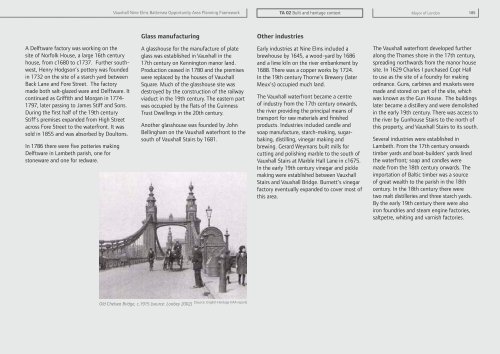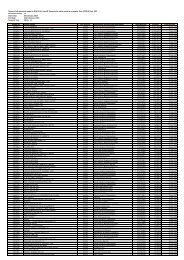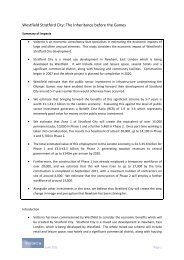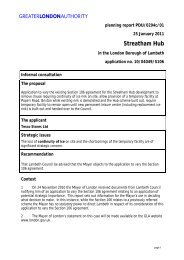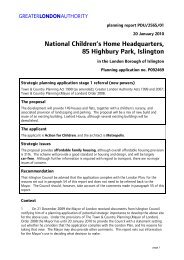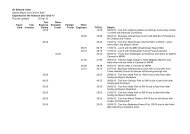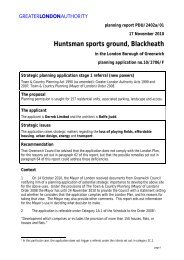Vauxhall Nine Elms Battersea Opportunity Area Planning Framework
Vauxhall Nine Elms Battersea Opportunity Area Planning Framework
Vauxhall Nine Elms Battersea Opportunity Area Planning Framework
You also want an ePaper? Increase the reach of your titles
YUMPU automatically turns print PDFs into web optimized ePapers that Google loves.
<strong>Vauxhall</strong> <strong>Nine</strong> <strong>Elms</strong> <strong>Battersea</strong> <strong>Opportunity</strong> <strong>Area</strong> <strong>Planning</strong> <strong>Framework</strong>TA 02 Built and heritage contextMayor of London 185Glass manufacturingOther industriesA Delftware factory was working on thesite of Norfolk House, a large 16th centuryhouse, from c1680 to c1737. Further southwest,Henry Hodgson’s pottery was foundedin 1732 on the site of a starch yard betweenBack Lane and Fore Street. The factorymade both salt-glazed ware and Delftware. Itcontinued as Griffith and Morgan in 1774-1797, later passing to James Stiff and Sons.During the first half of the 19th centuryStiff’s premises expanded from High Streetacross Fore Street to the waterfront. It wassold in 1855 and was absorbed by Doultons.In 1786 there were five potteries makingDelftware in Lambeth parish, one forstoneware and one for redware.A glasshouse for the manufacture of plateglass was established in <strong>Vauxhall</strong> in the17th century on Kennington manor land.Production ceased in 1780 and the premiseswere replaced by the houses of <strong>Vauxhall</strong>Square. Much of the glasshouse site wasdestroyed by the construction of the railwayviaduct in the 19th century. The eastern partwas occupied by the flats of the GuinnessTrust Dwellings in the 20th century.Another glasshouse was founded by JohnBellingham on the <strong>Vauxhall</strong> waterfront to thesouth of <strong>Vauxhall</strong> Stairs by 1681.Early industries at <strong>Nine</strong> <strong>Elms</strong> included abrewhouse by 1645, a wood-yard by 1686and a lime kiln on the river embankment by1688. There was a copper works by 1724.In the 19th century Thorne’s Brewery (laterMeux’s) occupied much land.The <strong>Vauxhall</strong> waterfront became a centreof industry from the 17th century onwards,the river providing the principal means oftransport for raw materials and finishedproducts. Industries included candle andsoap manufacture, starch-making, sugarbaking,distilling, vinegar making andbrewing. Gerard Weymans built mills forcutting and polishing marble to the south of<strong>Vauxhall</strong> Stairs at Marble Hall Lane in c1675.In the early 19th century vinegar and picklemaking were established between <strong>Vauxhall</strong>Stairs and <strong>Vauxhall</strong> Bridge. Burnett’s vinegarfactory eventually expanded to cover most ofthis area.The <strong>Vauxhall</strong> waterfront developed furtheralong the Thames shore in the 17th century,spreading northwards from the manor housesite. In 1629 Charles I purchased Copt Hallto use as the site of a foundry for makingordnance. Guns, carbines and muskets weremade and stored on part of the site, whichwas known as the Gun House. The buildingslater became a distillery and were demolishedin the early 19th century. There was access tothe river by Gunhouse Stairs to the north ofthis property, and <strong>Vauxhall</strong> Stairs to its south.Several industries were established inLambeth. From the 17th century onwardstimber yards and boat-builders’ yards linedthe waterfront; soap and candles weremade from the 18th century onwards. Theimportation of Baltic timber was a sourceof great wealth to the parish in the 18thcentury. In the 18th century there weretwo malt distilleries and three starch yards.By the early 19th century there were alsoiron foundries and steam engine factories,saltpetre, whiting and varnish factories.(Source: English Heritage HAA report)Old Chelsea Bridge, c.1915 (source: Loobey 2002)


